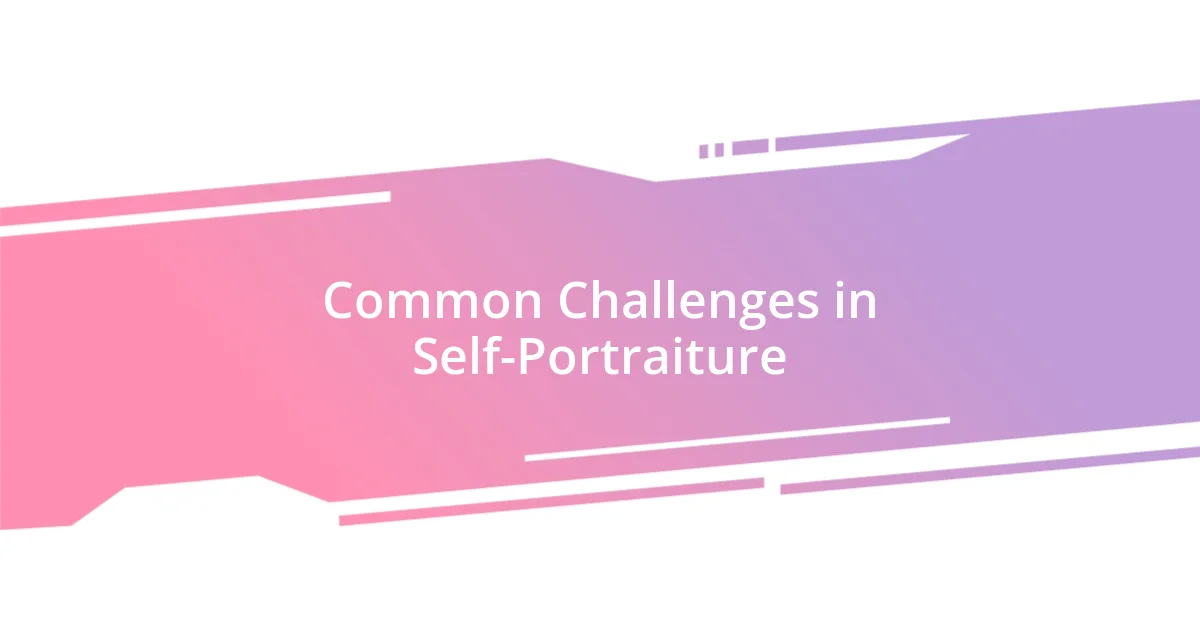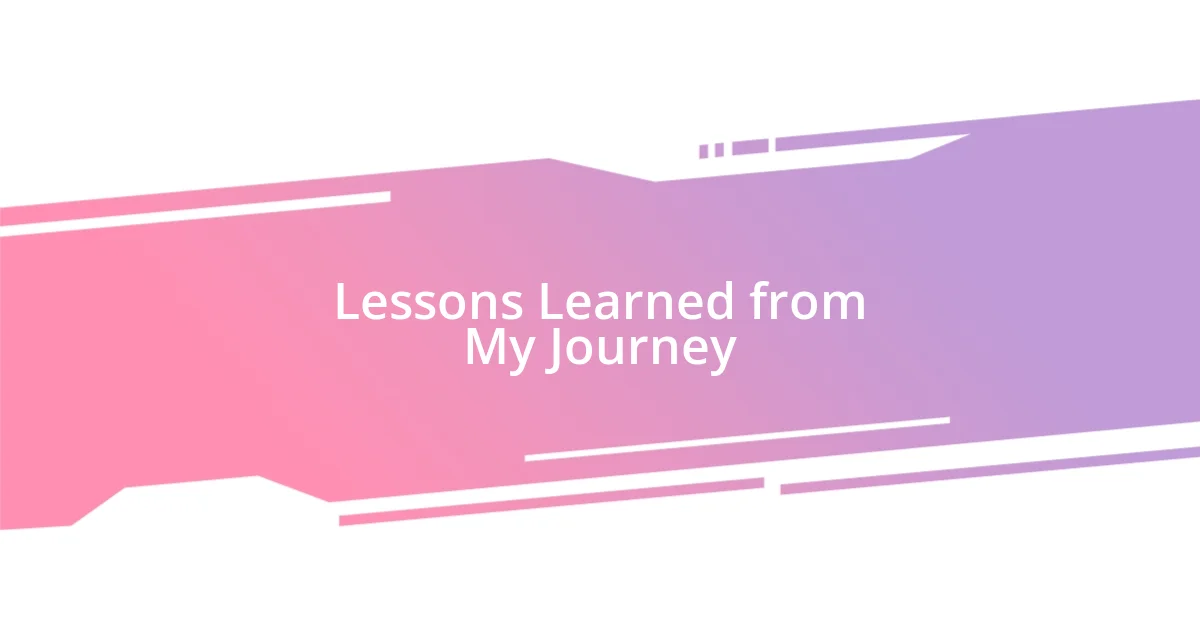Key takeaways:
- Self-portraiture serves as a profound means of self-exploration, revealing hidden emotions and fostering an emotional connection with viewers.
- Essential techniques for effective self-portraits include careful consideration of lighting, composition, and the inclusion of meaningful props.
- Key lessons learned from self-portraiture include embracing imperfections, understanding the power of narrative, and the importance of patience in the creative process.

Understanding Self-Portraiture
Self-portraiture is a powerful form of artistic expression that allows creators to explore their identity and emotions. I remember my initial attempts at capturing my own likeness; each brushstroke felt like peeling back layers of my personality. Have you ever considered how a simple image can reveal so much about the artist’s inner world?
In my journey with self-portraiture, I discovered that it’s not just about replicating my physical features. It’s an exploration of mood and atmosphere, a way to convey feelings that words sometimes fail to express. One particular piece, where I reflected on a particularly challenging period in my life, became a cathartic release. It made me wonder: how often do we express our hidden truths through art?
The beauty of self-portraiture lies in its dual nature—it serves both the artist and the viewer. I often find that my self-portraits evoke different emotions in others than what I initially felt while creating. This interaction challenges me and prompts introspection: what do viewers see that I might overlook? Exploring this dialogue through my art has become as meaningful as the act of creation itself.

The Importance of Self-Exploration
Self-exploration is essential for personal growth, and I’ve found that engaging in self-portraiture can be one of the most profound ways to uncover who we truly are. When I paint or photograph myself, I often stumble upon emotions I didn’t realize were lurking beneath the surface. It’s like holding a mirror up to my soul, revealing hidden fears and desires that I might otherwise overlook.
- It encourages vulnerability: Sharing my self-portraits often feels like exposing my innermost self.
- It fosters emotional connection: I’ve noticed that many viewers relate to the feelings I depict, creating a shared experience.
- It deepens self-awareness: The more I explore, the more I understand my motivations and insecurities.
I once completed a self-portrait that captured my feelings of loneliness during a transitional phase in my life. I used muted colors to reflect my emotional state, and when I looked at it later, I was struck by how vividly it encapsulated that period. This experience taught me that self-exploration through art isn’t merely an individual journey; it can resonate profoundly with others and initiate meaningful conversations.

Techniques for Effective Self-Portraits
When it comes to capturing an effective self-portrait, lighting plays a crucial role. I’ve experimented with both natural and artificial light in my work, and I’ve found that the right lighting can completely alter the mood of a piece. For instance, soft morning light casts a gentle, introspective quality, while harsh, direct light can evoke stronger emotions. Have you ever noticed how different times of day can influence your feelings? I certainly have; it feels like each lighting scenario unveils a new aspect of myself.
Another important technique is composition. I’ve learned to play with angles and framing to emphasize certain features or emotions. Sometimes, a simple shift in perspective can transform a portrait from ordinary to extraordinary. For example, positioning the camera slightly above my eye level made me appear more approachable, while a lower angle created a sense of empowerment. It makes me wonder how much our choice of angle can impact how others perceive us.
Lastly, incorporating props or objects that hold personal significance can add layers of meaning to your self-portraits. In one of my pieces, I included a book that had a profound impact on my life. The familiarity of the object told a story about my intellectual journey and aspirations. It’s remarkable how even small details can spark deeper connections with viewers, turning a simple image into a conversation starter about shared experiences and emotions.
| Technique | Description |
|---|---|
| Lighting | Natural or artificial light can set the overall mood and emotion of the portrait. |
| Composition | Experimenting with angles and framing emphasizes different features and feelings. |
| Inclusion of Props | Using meaningful objects can deepen the narrative and connection within the portrait. |

Choosing the Right Equipment
Choosing the right equipment for self-portraiture is essential in capturing the essence of who I am at a moment. I’ve dabbled with everything from my smartphone to DSLRs, and I can affirm that even a simple device can yield extraordinary results if used thoughtfully. Have you ever felt restricted by your tools? I used to until I discovered that sometimes a lower resolution could evoke a nostalgic or raw emotion that a high-definition image might not convey.
When it comes to lenses, I’ve found that prime lenses are particularly effective for self-portraits. Their ability to create a soft background blur really lets the subject—me—pop out in a way that tells more of a story. One time, while using a 50mm lens, I captured a moment of laughter that revealed a more genuine side of myself, something I hadn’t anticipated. It made me realize how a simple choice in equipment could open up a whole new realm of personal exploration.
Don’t underestimate the impact of a tripod either. For me, it’s more than just stability; it provides that crucial moment to step back and see my work as a whole before snapping the shot. Imagine setting everything up and then taking a breather, allowing the scene to speak to you. I often feel that stepping away gives me new energy and a fresh perspective, often leading to those ‘aha’ moments that turn an ordinary self-portrait into something truly striking.

Crafting Your Unique Style
Crafting your unique style in self-portraiture is a deeply personal journey. In my experience, it’s about connecting with what feels authentic to me. For instance, when I decided to incorporate vibrant colors that reflect my personality, the portraits began to resonate with my vibrant spirit. Have you ever played with colors just to see how they transform your images? It’s a liberating realization that your palette can tell your story.
As I navigated through different styles, I found myself gravitating towards a more candid approach. Capturing spontaneous moments often reveals parts of me that posed portraits don’t. There was this one time I captured myself dancing in the living room, completely lost in the music. The joy in that photograph epitomized a side of me that felt so natural and real. It made me wonder—how can you make your everyday moments your own art?
Over time, I’ve embraced the imperfections in my work. Those little flaws can convey authenticity, a touch of humanity that polished images sometimes lack. I remember a self-portrait where I accidentally caught my cat jumping into the frame. While initially frustrated, I decided to keep it. That spontaneous moment brought humor and warmth to the shot, reminding me that life is unpredictable and beautiful, just like my self-portraits. How do you feel about embracing imperfections in your creative process?

Common Challenges in Self-Portraiture
Self-portraiture often comes with a slew of challenges, and I can say that one of the biggest for me has been overcoming the self-consciousness that creeps in when I aim to capture my image. It feels like I’m constantly battling with the reflection staring back at me, questioning whether it truly represents who I am. I remember one particularly awkward session where I spent more time fidgeting with poses than actually taking shots. Can you relate to that feeling of awkwardness when you’re the subject of your own lens?
Another challenge that stands out for many, including myself, is the struggle to find the right expression. I’ve sat in front of the camera trying to channel deep emotions, only to end up with a bland or forced look. There was one evening, however, when I decided to play music while shooting. The right song transported me, allowing authentic emotions to flow, and what emerged was a portrait that felt genuinely me. Have you considered using music or even a specific mood to tap into your true self?
Lastly, the logistics of self-portraiture can be daunting. Setting up the shot, composing the frame, and then running to the camera often feels like a race against time. I once set up a beautiful scene only to miss the perfect shot because I didn’t account for the timer’s delay. It taught me the value of preparation; now I often mark my position or use a remote shutter to save myself the hassle. How do you tackle the challenges of timing in your creative endeavors?

Lessons Learned from My Journey
The journey of self-portraiture has taught me the significance of self-acceptance. I vividly remember a moment when I stared at a series of portraits, critiquing every little detail. But then, one image captured a moment of vulnerability—my unfiltered self. The reflection of my flaws suddenly felt beautiful, and I realized that authenticity often shines brightest in our imperfect moments. Have you ever encountered a photo that resonated with you not despite its imperfections, but because of them?
Another lesson has been found in the power of narrative within each portrait. I started experimenting with props that represented different facets of my life. One day, I took a guitar into the frame, symbolizing my love for music, and it brought a new dimension to my expression. It was fascinating to see how an object could forge a deeper connection with the viewer. Have you thought about how incorporating elements of your story can transform a simple image into something profound?
Finally, I discovered the importance of patience in my creative process. There were days when I felt rushed, trying to replicate the polished portraits I’d seen online. After facing numerous disappointing results, I learned to slow down and savor each moment. One quiet afternoon, I found myself enjoying the act of photographing rather than fixating on the end result. It shifted my perspective, making each session feel less like a chore and more like an exploration. How do you remind yourself to enjoy the process rather than just focusing on the outcome?














